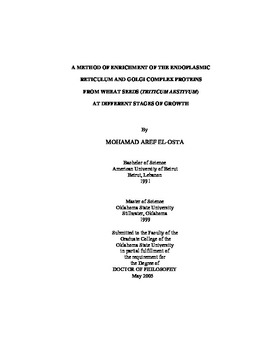| dc.contributor.advisor | Rayas-Duarte, Patricia | |
| dc.contributor.author | El-Osta, Mohamad Aref | |
| dc.date.accessioned | 2013-11-26T08:22:52Z | |
| dc.date.available | 2013-11-26T08:22:52Z | |
| dc.date.issued | 2005-05 | |
| dc.identifier.uri | https://hdl.handle.net/11244/6642 | |
| dc.description.abstract | Scope of study: Bread wheat (Triticum aestivum) is an important economic crop in the US and the world and its quality is related to storage protein. This study attempts to describe the proteins associated with the endoplasmic reticulum (ER) and Golgi complex (GC) of wheat endosperm. These proteins can be later used to related different aspects of storage proteins synthesis during endosperm development. The rate of reserve materials accumulation varies during the grain filling stages of wheat (early, early-mid, late-mid and mature, 7, 14, 34 and 60 days after anthesis, DAA, respectively). The constitutive proteins of the ER and GC are speculated to undergo changes in function, and possibly a temporal change in protein expression during these stages. The temporal change in protein composition within these organelles may be related to wheat proteins quality. The objective of this study is to develop a methodology for enriching organelles fractions from endosperm wheat and identify the constitutive proteins of these organelles at different stages. Enriched ER and GC fractions were obtained by discontinuous sucrose gradient fractionation and two-phase partitioning. Proteins were separated by 2-D electrophoresis and identified by peptide mass fingerprinting MALDI-TOF and MS-FIT database search. | |
| dc.description.abstract | Findings: The non-linear change in seeds weight confirmed that grain filling passes through different stages, including a change in protein rate filling as shown by protein determination assay (53.4, 69.6 and 101.4 mg/ml in 7, 14, and 34 DAA respectively). The enrichment of ER and GC was confirmed by immunodetection of enzymes markers. In SDS-PAGE, the enriched organelles fractions showed a difference in protein bands distribution at 34 DAA compared to earlier fractions (above 75 kDa and between 15-20 kDa), suggesting a diversity in organelles functionality, possibly due to a shift in major functions from protein synthesis to storage. At various stages, both enriched ER and GC showed a trend of similarity at 30-35 kDa, possibly due to the presence of common transport-related proteins in both organelles. Despite the limited solubility of the organelles in 2-D electrophoresis, a total of 234 spots were separated, 85 (36%) of them were fingerprinted by the MALDI-TOF and database search. Some identified proteins were markers for specific stages of development as PDI, starch synthase and nucellin-like aspartic protease. | |
| dc.format | application/pdf | |
| dc.language | en_US | |
| dc.rights | Copyright is held by the author who has granted the Oklahoma State University Library the non-exclusive right to share this material in its institutional repository. Contact Digital Library Services at lib-dls@okstate.edu or 405-744-9161 for the permission policy on the use, reproduction or distribution of this material. | |
| dc.title | Method of enrichment of the endoplasmic reticulum and Golgi complex proteins from wheat seeds (Triticum aestivum) at different stages of growth | |
| dc.contributor.committeeMember | Mort, Andrew J. | |
| dc.contributor.committeeMember | Soulages, Jose L. | |
| dc.contributor.committeeMember | Anderson, Michael P. | |
| osu.filename | El-Osta_okstate_0664D_1342.pdf | |
| osu.accesstype | Open Access | |
| dc.type.genre | Dissertation | |
| dc.type.material | Text | |
| thesis.degree.discipline | Biochemistry and Molecular Biology | |
| thesis.degree.grantor | Oklahoma State University | |
